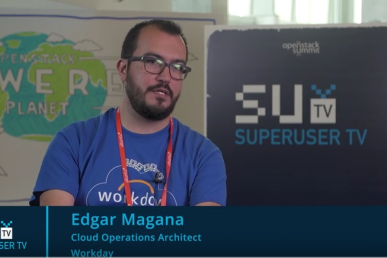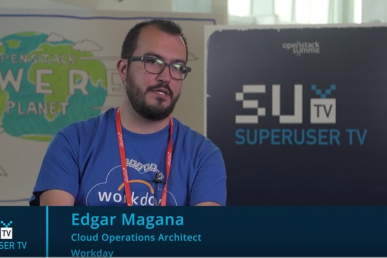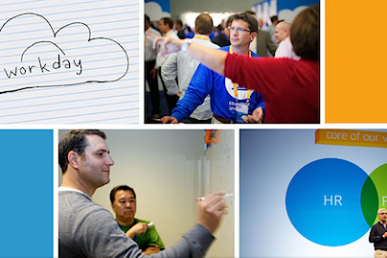Since launching in 2010, the OpenStack world has expanded, matured and evolved to reach a wide array of companies and use cases. Superuser asked three community members about the biggest changes they’ve seen and what’s ahead.
• Edgar Magana,
cloud operations Architect at Workday.
Magana has been an OpenStack member since 2011 and is a member of the User Committee. He has contributed to Neutron (founding member), Nova, Devstack, docs, Rally and Heat and currently leads the contributions on the networking guide.
• Victoria Martinez de la Cruz, software engineer at Red Hat.
Martinez de la Cruz is a full-time contributor to the Zaqar and Trove projects as well as the OpenStack Outreachy and Google Summer of Code internship programs coordinator.
• Boris Renski, co-founder and CMO at Mirantis, the pure-play OpenStack company, and serves on the Board of Directors of the OpenStack Foundation.
What have been the most significant developments in OpenStack in the last year and what drove those changes?
Renski: This year, we shifted from a period of excitement over OpenStack’s potential to an era of maturity. The players in the market are now bigger, better funded, and tougher. OpenStack’s use cases are more defined. Customer expectations are higher. Analysts have shifted from saying that OpenStack is a risky science project to optimistically acknowledging where OpenStack wins. It’s a more serious and cleaner landscape—and that’s a good thing.
Martinez de la Cruz: I think that the most important changes are the ones that have helped OpenStack be defined as an abstraction solution rather than a virtualization tool. The enhancements on containers support have been one of the most exciting changes since they provide operators a flexibility that wasn’t available before.
Are you seeing any differences in how OpenStack is being applied to business use cases? Have you seen a difference in how they perceive OpenStack? Their approach?
Martinez de la Cruz: I sure am! Use cases for OpenStack have evolved a lot. A few years ago OpenStack was adopted only by big players that needed to automate their infrastructure or for companies performing "experimental" deployments. Now OpenStack has gained more adoption in real enterprise use cases and it’s more flexible for diverse kinds of users. I think OpenStack has gained trust, and that influences a lot of why and how OpenStack is being used.
Magana: A change that I have observed from the business and usability side is that companies are getting interested about OpenStack because some of the new projects satisfy a gap in their current technology pipeline. OpenStack is not about all or nothing. Operators may build their clouds with the components and drivers that will fulfill their feature and performance requirements.
From a workload perspective, are you seeing all purpose cloud native, or does something stick out to you, be it NFV, hybrid cloud, e-commerce?
Magana: It is a bit of both. That is one of the best things about OpenStack; there is no perfect formula on how to use it and which projects to deploy. It provides enough flexibility to cover business that urgently need NFV-capable environments, as well as those who just need to jump from a private cloud to a hybrid one.
Renski: Historically, the mainstream OpenStack use case has been a developer community using OpenStack inside a large enterprise for building apps. Lately we’ve also seen an increase in aspirational interest in using OpenStack for network functions virtualization (NFV) and internet of things (IoT). The NFV community is excited to throw out their bulky networking gear, and many companies are kicking off IoT initiatives where a private cloud will be the central backend for devices. OpenStack is a good solution for both.
Where do you think OpenStack is headed and what will change the most in this coming year?
Renski: This year I think we’ll see the main narrative change from “keeping OpenStack open” to “making OpenStack work.” For a long time, the community was focused on defining OpenStack as an open source, ever-pluggable framework, and a community where all parties had an equal voice. That conversation has settled. The openness of OpenStack is much more clear. The Big Tent model has been adopted. Now the conversation will evolve to “making it work.” We will hear a lot more about prescriptive reference architectures, partner integrations, different consumption models like appliances, customer stories, and more sophisticated discussions around how OpenStack clouds can be implemented.
Magana: The biggest change from my perspective will be that OpenStack will no longer create plugins or drivers to be adapted to existing technologies, but new technologies will be designed having OpenStack in mind as their defacto management system. I anticipate seeing more confidence around new projects and better, simpler practices to deploy and support OpenStack-based clouds.
Martinez de la Cruz: I expect OpenStack to gain even more stability, to be easier to deploy and maintain, and to enhance interoperation with other clouds. And I think we are moving towards that path. Lots of effort has been put on those aspects in the last couple of months and I’m really looking forward to see the positive outcomes of those in the upcoming releases.
Do you have other predictions about OpenStack, the platform or the community?
Renski: OpenStack has established itself in the wake of a massive cloud infrastructure movement sparked by AWS. CIOs and developers see it as the open source way to do cloud, and we will see OpenStack adoption grow as broader market cloud adoption takes off.
Martinez de la Cruz: Oh yes; OpenStack is not only software, but also a great community. And from that point of view, I see the OpenStack community getting bigger and a lot more diverse!
This article first appeared in the print edition of Superuser magazine, distributed at the Austin Summit. If you’d like to contribute to the next one, get in touch: [email protected]
Cover Photo // CC BY NC
- Five ways to make your OpenStack Summit talk a standout - October 10, 2018
- Say hello to Kata Containers 1.0 - May 22, 2018
- How to make your OpenStack Summit talk a big success - April 6, 2018

)










